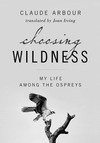
Choosing Wildness: My Life Among The Ospreys
Claude Arbour
Greystone Books
$24.95
paper
242pp
978-1-55365-297-7
The chapter on nesting sites typifies Arbour’s narrative charm. He tells his dogs he won’t be travelling with them today (“they watched me thoughtfully”), and heads down a trail “bordered by blueberry and Labrador tea bushes, strewn with dead leaves whose faint perfume of fermentation quickened the mind.” He arrives at a bog where he has spotted a tree just right for an osprey nest (ospreys prefer pines or spruces with broken tops). Then he describes exactly how he builds a platform that will encourage ospreys to hatch their chicks there. At the end the reader knows not only how to make a nesting site, but how to climb a 30-metre pine and how to tell if the tree is safe, how many years ospreys will return to the nest, and how long it takes their young to incubate. All this in 1500 unhurried words.
The book is a series of short, discrete chapters, narrated in Arbour’s friendly voice: telling you how acid rain and logging dams affect fish and why the balance of fish in the lake affects the ospreys, why otters love to slide in the snow, or how to attract a marten (burn birchbark: they love the smell). You’ll also learn the ins and outs of privies in winter (a heat-reflecting seat is a must). Throughout, there’s a sense of seasons passing on the Canadian Shield. The prose often rises to unforced poetry (“loons, the great tenors of our summer nights”), fluently rendered in Joan Irving’s translation.
Arbour combines a scientist’s ability to synthesize facts with a writer’s talent for the telling detail, plus an amateur’s enthusiasm. The latter sometimes borders on obsession: asked to do a monthly survey of bird species in a 10-kilometre territory for four months, he decides he’ll extend it to two years and 1,000 square kilometres, and will survey not only birds but also plants, mammals, fish, reptiles, amphibians, soil types, and minerals. “I had bitten off a rather large chunk,” he says, with typical understatement. It’s more like painting the Brooklyn Bridge: the territory takes him a month to cover (by canoe), and then he has to start all over again. But he never tires of life in the wild.
At the book’s end, reflecting on over 20 years at Lac Villiers, Arbour comes as close as he ever does to self-congratulation when he says the nesting sites he’s built have hatched over 200 ospreys. Here’s a man who loves what he’s doing and knows he’s doing good work.
The author got his professional start when philosopher Jacques Dufresne put together a deal that Samuel Johnson would have recognized: a subscription. One hundred people forked out $100 each, in return for which Arbour took up full-time residence at Lac Villiers and began writing the material that eventually took the form of this book. It’s heartening to know that this useful tradition of literary commerce is still being honoured. mRb






0 Comments